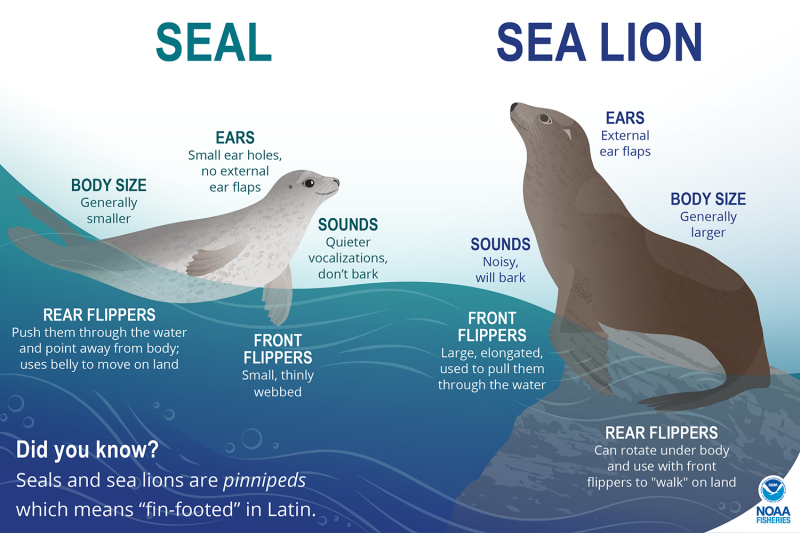
What is a pinniped?
Pinnipeds – sometimes called seals – are the group of marine mammals that includes the true seals, fur seals, sea lions, and the stately tusked walrus. Altogether, there are 33 living species of pinnipeds. They are found in Antarctic and Arctic waters, and along coasts around the world.
Pinnipeds spend most of their lives in the ocean, hunting down tasty krill, squid, and fish. Their streamlined bodies, flippers, and tails are adapted for their aquatic lifestyle. Their natural predators include orcas (killer whales), polar bears, sharks, and sometimes people.
Pinnipeds come on land (or ice!) to mate and have their babies. Some pinnipeds, like the California sea lion, are very social and gather in large groups in the water and on land. Others, like the leopard seal, are mostly solitary.
While some pinnipeds are doing well in the wild, several species are at risk or endangered, like the Hawaiian monk seal and the Mediterranean monk seal.
*For a deeper dive into the biology, behavior, and conservation status of pinnipeds, check out the resources listed at the bottom of this page.
Know how to tell your pinnipeds apart
True seals (also known as earless seals) belong to a group called Phocidae. True seals have ear holes, but do not have external ear flaps. They wiggle on their bellies when on land, and they are a quiet(ish) bunch. Sea lions and fur seals (the eared seals) belong to a group called Otariidae. They have external ear flaps and they can “walk” on their flippers. They are more social than true seals and they tend to be noisy communicators! Walruses belong to a group called Odobenidae. Walruses are large and have tusks.
Study the image below and then take our pinniped challenge!

If you’d like more information, check out this resource from NOAA Fisheries about the differences between true seals and sea lions.
Pinniped challenge!

All images via Canva.com for educational purposes
How to help pinnipeds
Here are 3 easy ways you can help your local pinnipeds:
- Pinnipeds need a clean marine environment. You can help by carefully disposing of your waste so it doesn’t end up in the ocean. Or, you can gather some friends and organize a beach cleanup.
- Pinnipeds need their personal space. Keep pet dogs on leash and away from seals. Although pinnipeds have big eyes and look sweet, they are wild animals. It’s not a good idea to approach them. Please don’t try to touch them or feed them or take selfies with them. Giving them space helps keep them healthy and keeps you safe too. A safe distance for people and pets is about 50 yards (46 m) back.
- Report sick or injured seals and sea lions. If you do notice pinnipeds in trouble, ask an adult to help you contact your local marine rescue center. NOAA provides contact information for reporting injured marine animals in the USA.
You may like these stories from Mongabay Kids
Meet the Mediterranean monk seal

Seals help scientists study the Southern Ocean

Pinniped learning resources
- Seals, sealions, and walruses. An extensive resource on pinniped biology. From Smithsonian Ocean
- What’s the difference between seals and sea lions and more information here. From NOAA.
- Seal vs. sealion: your guide to knowing the difference. From the Marine Mammal Center
- Learn about Antarctic seals and sea lions. From the Australian Antarctic Program
- Sea lion live cam from OrcaLab/explore.org. There’s nothing better than watching pinnipeds live! Observe Steller sea lions at one of their hangout spots in British Columbia. Learn more about this location and the best times to view the sealions at explore.org.
Posted by Megan Strauss for Mongabay Kids, banner illustration by Maria Salazar






